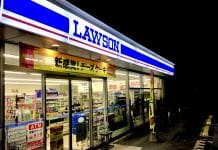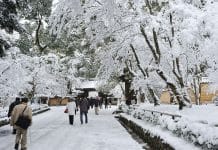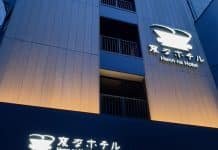Address: 10-5 Senri-Manboku-koen, Suita-shi, Osaka 565-0826. Tel: 06-6877-1971. Open: 10:00-17:00. Closed: Wed.

Table of Contents
Intro
I first heard about the soba choko exhibit at The Japanese Folk Crafts Museum (aka “Mingeikan”) in Osaka from my cousin Tomomi not long after my grandma Yoshiko Obaachan’s passed. She was an avid collector of Japanese folk art and we poured through her entire collection of dyed cloths (shibori), prints, and pottery.

One of the interesting things I inherited from her were soba choko -small intricately painted porcelain cup for dipping noodles dating back to the Edo times.) As we sifted through a 95 year lifetime worth of treasure, I started to become as passionate about these crafts as she was (Obaachan had always said it was her wish that I become so.)

She had been a member of the museum for a 30 year period from the 60’s to 80’s. On top of that she would meet up with a group of Japanese folk art collectors who would travel to meet the craftsmen who made these objects. People like Yunoki Samiro and Serizawa Keisuke who are now legendary figures in Japan. Samiro, who lived to 101 helped decorate the Ace Hotel in Kyoto -my grandma had a number of his prints as well. When I was born she had to put her mingei passion aside to help look after me while my mother was at work. She imbued in me not only a love for Japanese folk art but for cooking as well (and served the food in the bowls she collected.)

Like a benign virus, the love for this ancient Japanese art spread to my cousin and I. As I helped my Grandma do “shuukatsu,” (which means “preparing for death” in Japanese) I started to learn about her collection -even prior to her passing. We talked about how the tradition was passed from master to student and how Yoshiko had been lucky enough to meet these historical figures while they were still alive. Their sons and daughters now continue their creative tradition in contemporary times.
A staff member from the Tokyo branch of the Japanese Folk Crafts Museum had come all the way to Kobe to see some of my Grandma’s collection and was shocked not only at the priceless pieces she had but that her apartment was covered in folk art. “This house is filled with love for mingei” she said, “it’s everywhere!” The curtains, the pillowcases, furniture, plates, and vases -you couldn’t turn your head without seeing it.
We sat down and had tea with our guest on chairs and tables made from historical Matsumoto furniture -handmade in Nagano by precision craftsmen and valued all across Japan. So prized indeed that Matsumoto furniture exhibitions often come to Osaka to have art shows themselves (including at the Japanese folk art museum!)

My cousin told me there was an exhibit showing stuff like Obaachan collected: soba choko -and that I should go see it. The exhibit ran from March 2 to July 16th so if you’re reading this now it’s already finished but be sure to check out the website to see what’s on display now! I had wanted to go with my grandma but at 95 years old she was too weak to go. Now I finally got my chance to visit -by myself which was somewhat bittersweet.

The museum is located in the Expo Commemoration Park home to the Tower of the Sun monument created by Taro Okamoto for Expo ’70, the World Fair in Osaka.The park is chock full of activities to do in addition to the exhibit which include The National Museum of Ethnology, Osaka Expo ’70 stadium, Natural and Cultural Gardens (including a Japanese Garden) and more!

It was a slightly rainy day and there were very little tourists. The last time I visited was during the sakura festival here with blooming trees and food stalls packed with people. So I was surprised at the emptiness but relieved not to have to push through shoulders to get to where I needed to go.
Getting to the Park
Osaka Dot Com writer Sam joined me as we got off at Yamada station which was a short walk from the park. It added an extra 20 minutes to our journey but since it wasn’t boiling hot yet, it was doable. We had lunch at the Dew Hankyu Yamada Shopping Center. I had packed a bento lunch and we ended up munching it on the benches at the mall. We had wanted to do a picnic at the park (which is a great spot for it) but it was raining and muggy.
We finished our meal and as we headed toward our destination we stumbled upon an interesting manhole cover. Everything around here seemed to be Tower of the Sun themed. It made sense as we soon found out -it was an incredible sight to behold seen in the flesh.

As we walked along we could see the monorail sliding above us. It could be ridden to the park for a couple hundred yen and we enjoyed the view of it as we walked along.

Even from far away we could see the giant monument peering over the trees. It was quite surreal. I’ll mention that even if you take the monorail to the park entrance, it’s still around 15 minutes or so to reach the museum on foot so plan accordingly!

Arrive at the Park
Before entering the gates there was an interesting Family Mart that had lots of Expo and Taro Okamoto goods. It was intriguing to see these trinkets in a convenience store, certainly the only one I’ve seen offering them -perhaps they were limited edition Family Mart items. A nearby souvenir shop also sold the artist’s goods so I went to compare and contrast to see the difference.






The entrance to the park and the museum ticket combo were 710 yen. With the price of exhibitions these days being at least 2000 yen -this was a steal! Once entering the park I was struck by the view of the colossal sculpture which greets you at the entrance. I took lots of pictures and there was even a little tool to set your camera on for taking a selfie -very convenient! I started to wonder about next years World Fair mascot Myaku-Myaku.. would they erect his monument design as well?



As I walked past the giant structure I appreciated it from all angles and enjoyed the rose and tulip gardens which lined the paths to the Folk Craft museum. Beautiful (and smaller) sculptures were scattered about and provided an outdoor “exhibition” of sorts. You could really spend a whole day here (if not MANY days.)


I arrived at the entrance to exhibition and became momentarily distracted by the gift shop. It wasn’t just selling any old junk -there was actual pottery, glassware, and crafts handmade by the artists! It was a museum in its own right. I excitedly noticed everything from my grandmas house here in the shop. She must have walked in here and discovered all of her favorite artists so long ago: the Mastumoto furniture, Yunoki Samiro prints, the work by her contemporaries who had now become historical figures in their own right. They were not expensive! Most were under 10,000 yen (less than 100 dollars) so it really was art for the “common man” (as mingei is intended to be.) The great thing about Japanese folk crafts is they’re less meant to be displayed but used day-to-day.

Soba Choko Exhibition
But I couldn’t spend the whole day in the store, I had to head into the exhibition! Once I entered inside I saw a whole room filled with soba choko cups -from wall to wall! There were sizes from big to small and so many different types as well! Who knew! The bunny design from the show pamphlet immediately popped out as well as the kintsugi pieces (broken pottery that is fixed with gold leaf.)

I even saw a piece that had been completely broken in half, stuck back together with kintsugi. It’s a delicate and difficult art that can only be done by craftsmen who study for many years. A broken piece of pottery (like soba choko) that’s inlaid with kintsugi can ironically become more valuable after it’s cracked! (I wont be smashing my inherited cups anytime soon!) My grandma had these plates and cups on her mind when she was in the hospital. She could barely speak, she leaned in close to whisper something -perhaps a last dying message, I thought. She said “make sure not to microwave the kintsugi.”

But she didn’t have to worry about the soba cups, most seem very thick and the bunny choko that I inherited have fallen many times and never broken! We use them to drink tea as well. The most valuable ones are hidden in the back of the cuphoard and the rabbit cups are for daily use.

In the exhibition, however, were more than my Grandma ever had -there were over 1000 pieces selected from the 3000 pieces donated by Mr. Sato in 1979. (How he had room for 3000 cups in his house I’ll never know!) These soba choko were all considered “koimari” type which is imari-yaki from the Edo times created in the Arita region. Shipped from the Imari port thus called “Imari-yaki” “ko” meaning old.

As I wandered through the displays I read about how each design on the cups has a different meaning. While most of them have a blue and white designs -some also have a red color or otherwise. I was interested in the designs I’d never seen. These motifs included: plants, animals, people, nature scenes, geometric designs, and letters.
The meaning for each style is as follows:
・Pine tree: an evergreen tree that survives a harsh winter signifying longevity.
・Bamboo: grows fast and strong symbolizing strength.
・Ume cherry: grows in early spring in the cold representing fertility and life force.
The kanji for these 3 put together is read as “shou-chiku-bai” meaning good luck.




Also there is:
・Bat in the shape of an “M”: comes from a “fuku” pronounciation of Chinese that also means good luck in Japanese. (Strange that a bat would be auspicious!)
・Ume and eagle/ flower and bee: close friends, getting along, being friendly etc.
・Seigaiha (wave pattern) – represents the ocean (my grandma loved this motif the most!)
・Narcissus flower: auspiciousness.
・Bunny: fertility.
2nd Exhibition Area
As I exited the main displays there was a hallway leading to a 2nd exhibition area as well which showed old kimonos, aizome (blue-died cloth), and other textiles created by the masters.
Like the park, there were only a few visitors in the museum that day, so it was a relaxing visit -unlike The Louvre where trying to see The Mona Lisa was like a crowded rock concert. (Suffice it to say I wasn’t “head-banging” to her mysterious smile.)



As I turned the corner and came upon countless exhibition rooms it was certainly larger than the tiny building appeared.There were lots of Matsumoto benches and places to sit and take a break -even a mock living room and I wasn’t sure if I was allowed to use them!

Gift Shop
After exiting I came back to my beloved gift shop and spent another hour there. One highlight was the section for each pottery type listed as (fill in the blank)-“yaki” or (fill in the blank) -“gama” depending on the region and style. It was informative to see each piece’s style and color and learn about the different types of Japanese folk craft. It’s much better than seeing them in a book since you can touch them, look up close.and see the textures and glazed surfaces. I definitely recommend visiting the museum for anyone interested in getting intimate with Japanese pottery (in an appropriate way.)
It was the best gift shop for a museum or theme park of any I’d been too. I thought about how if I ever broke one of my inherited plates I could come again to buy a new one at a reasonable price (even if it wasn’t EXACTLY the same one.)







The Japanese folk crafts attention to small details and dedication to being handmade even extended to these wooden plate holders. I had inherited some myself and was glad to see them here: Yanagisawa Mokkou a famous Japanese crafts carpentry firm. They also make lights, wooden frames, etc.

The museum held on to my belongings while I looked at the exhibit -what a great service! I could focus on the art and see the gift shop without worrying about dragging my stuff around. The staff were very polite and gave us tips about fun stuff to do in the park as well i-ncluding visiting the pizza place near by (Pizza Cafe North Garden) that has a special Japanese craftsman-built brick oven pizza that is very delicious!

Also in the park
All in all for 710 yen it was a worthwhile experience! Besides galavanting around the museum the park offered a full day’s worth of activities! Close by we took a quick stroll through the Japanese Garden -which was too big to see all of. I enjoyed the koi fish who swarmed around us as we peeked into the pond waiting to be fed! (Who knew that fish could beg for food!) I had only been to these types of gardens in the states but the quality in Japan was (naturally) much better! There were even some turtles too!




Kyoto tourist spots are packed so it’s better to come here to avoid the crowds. I would have been able to spend some more time outside if it was a little cooler but in a couple of months or so it shouldn’t be an issue! We retreated to the air conditioning in The Museum of Ethnology building which may have the greatest library in all of Osaka. Over 5 floors of 700,000 books from all around the world and it’s completely free to visit.



After arriving home fresh from seeing the wonderful exhibit of cups I decided to make a meal using my own. This is my collection of soba choko inherited from Obaachan.

I used handamen (not soba) which were her favorite type of somen. She would often eat it for lunch, especially during the summer. Like soba you can dip them to add flavor.

I added egg, peppers, and spice to add a little nutrition to a simple dish. I also used my grandma’s Japanese folk craft plates as well. These dishes are beautiful to look at as well as enjoy the memories they contain from the years of use.







Everything tastes so much more delicious when you eat it from these plates, it’s a taste of summer! I hope you enjoy some great noodles and exhibitions like I did and let me know in the comments!
Until next time!




















